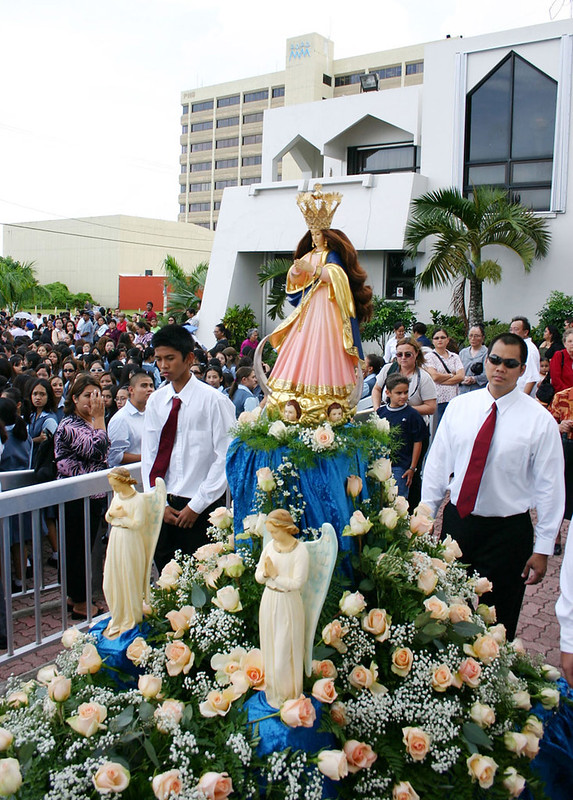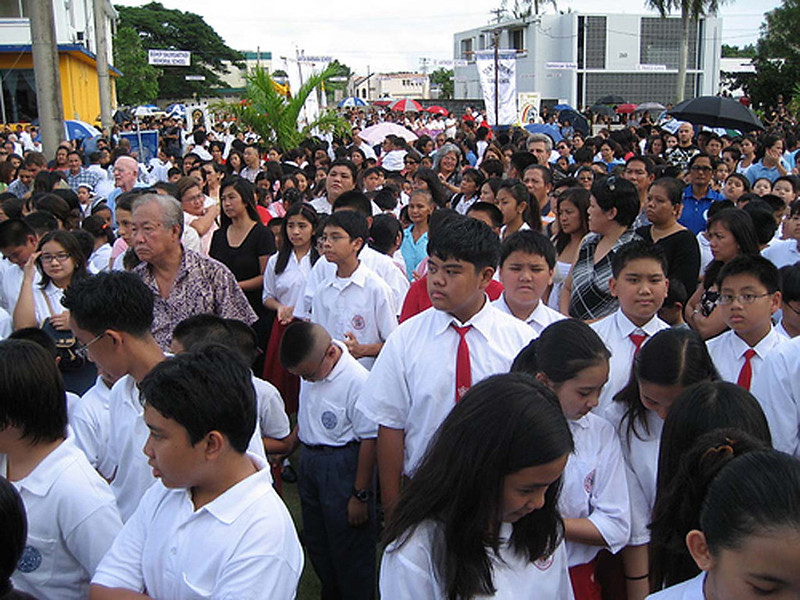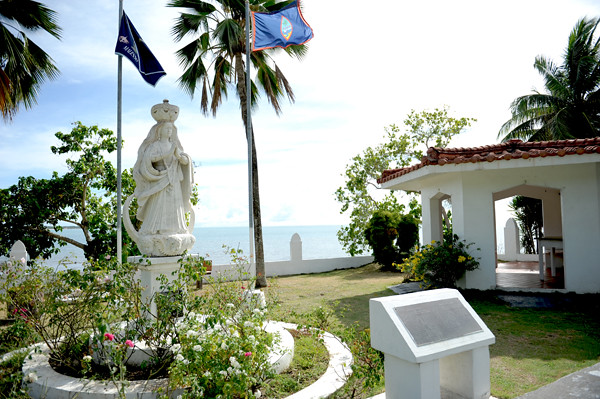Patron Saint of Guam
Santa Marian Kamalen, also known as Our Lady of Camarin, is the patron saint of Guam. The 300-year-old Santa Marian Kamalen statue is a revered icon, and although its origins are unknown, they are explained through oral tradition. Every year on 8 December, the Feast of the Immaculate Conception is celebrated, and Guam Catholics turn out by the thousands in Hagåtña to honor Santa Marian Kamalen in a procession around the island’s capital.
The statue of Santa Marian Kamalen is 28 3/4 inches tall and weighs 48 1/2 pounds. It is made of wood, except for the ivory face and folded hands. She is painted with a regal pink and blue gown and sits high in the Dulce Nombre de Maria Cathedral-Basilica in Hagåtña in a niche in the sanctuary wall behind the altar.
Santa Marian Kamalen’s origins are shrouded in legend and she was the subject of front-page headlines when she was stolen from her home in the cathedral on three separate occasions in the last few decades. She is one of the most important icons in Guam’s history, religious or otherwise. A longtime effort to place a replica of the statue in the Basilica of the National Shrine of the Immaculate Conception in Washington DC was realized in 2006.
Legendary origins
The origin of the Santa Marian Kamalen statue has not been documented until recently, but by oral tradition multiple versions of a legend exists about her origin.
According to one version of the legend, a fisherman from Malesso’/Merizo went spear fishing in Babang Bay, between Merizo and Cocos Island, and with astonishment spotted a statue of the Virgin Mary on the ocean floor. He swam underwater to try to approach the statue, but to his surprise it retreated. No matter how hard he tried, he could not close the distance between the statue and himself.
Puzzled, he returned to shore and sought advice from the village priest. The priest told the scantily-clad fisherman to dress in his Sunday clothes and try again. He did so, and this time had no trouble in getting the statue.
Another version of the legend has it that the fisherman saw the statue floating in the water, escorted by two gold-spotted crabs, each bearing a lighted candle between its claws. She thus also became known as the Lady of the Crabs.
When the fisherman, who was a member of the Dotacion, or native militia, returned to his required two months of active duty in Hagåtña, he took the statue to the Presidio, or main barracks which were still under construction. There the statue was relegated to a tool shed, in Spanish camarin and in Chamorro kamalen. Thus, she became known as Santa Maria del Camarin in Spanish or Santa Marian Kamalen in Chamorro. She was also known as the Lady of the Barracks.
She was then adopted as the Dotacion’s patroness and when the Presidio was completed in 1736, placed in its chapel. The Dotacion celebrated the feast day of their patroness on 8 December, and this continued until the Dotacion was disbanded in 1884 after several of its members were involved in assassinating the Spanish governor, Don Angel de Pazos Vela-Hidalgo. Santa Marian Kamalen was then placed in the church of Dulce Nombre de Maria, which later became the cathedral.
Origin speculation
When Father Oscar L. Calvo brought the statue to Manila in 1948 to be refurbished, art connoisseur Maximo Vicente identified the statue’s wood as molave, a hard wood native to the Philippines. Vicente determined the statue to be contemporary with the oldest images in the Philippines, such as the Nuestra Senora de Paz y Buen Viaje of Antipolo and Nuestra Senora de Guia in Ermita Church, Greater Manila.
Based on a rusted iron plate found on the bottom of the statue, Calvo speculated that the statue came from a Spanish galleon that sailed between Acapulco, the Philippines, and Guam. Galleon crews, according to custom, gathered before such a statue reciting the litany and singing the Salve Regina. The galleon Nuestra Senora del Pilar sank off the coast of Cocos Island in 1690, before the building of the Presidio.
The legend of the origin of the statue and its name is most commonly accepted by Guam residents. Historian Paul Carano speculated on other possible origins of the name, including one that centers around the statue’s probable Philippine origin. He proposes the name could have been related in some way to the names of the provinces of Camarines Norte and Camarines Sur on the island of Luzon in the Philippines.
Carano also said the name might be related to the Spanish word camarin, which means a place behind an altar where images are dressed, and the ornaments destined for that purpose are kept.
Other Santa Marian Kamalen legends
Numerous other legends exist around the patron saint. Legend has it that when the Spanish militia men were about to retire for the day, if they have indulged in more tuba (fermented coconut palm sap) and aguardiente (high-potency alcoholic beverage) than is prudent, they often fell asleep while saying their prayers or would act immodestly before the statue when drunk. The doors of the niche would slam shut violently, waking the sleepy soldiers so they could finish their prayers.
One of the more famous legends is that of a great earthquake in 1902, when the Dulce Nombre de Maria church was severely damaged. Many of the statues of the church were broken but not that of Our Lady of Camarin, which the pastor, Father José Palomo, found standing intact on the ground.
The statue also survived fire, when on 8 December 1945, it was rescued from a burning float by Jose D. Leon Guerrero.
Because the statue has suffered discolorations, nicks and other minor defects in the course of time, minor repairs have been made. According to one story, during one occasion when repairs were being made, the scraping of her face was too rough, and the face began to bleed.
Other miracles attributed to her include belief in her powers of intercession, cures of dreadful diseases, and safe removal from great danger. She has long been considered by many the protectress of the island and its people.
World War II
One of the more well-known stories about the statue took place when Japan bombed Guam and Pearl Harbor, Hawaii as war broke out between America and Japan during World War II in 1941. Guam was bombed on 8 December, the day of the Feast of the Immaculate Conception. Throughout the war, the statue was cared for by a teenager named Mariquita “Tita” Torres (who later became Mariquita Torres Souder), after Father Jesus Baza Duenas, who was beheaded by Japanese soldiers shortly before the US recapture of Guam, took the cathedral’s valuables to the Torres family home in Maite.
The Japanese ordered everything returned to the church and followed Duenas to the Torres residence. While there, a soldier asked for the statue standing in the family’s living room, but Tita Torres claimed it belonged to the family, not to the church, and that it was only lent to the church on special occasions. Duenas vouched for this and told the officers that it was not the church’s property.
Torres carried the statue to the family ranch near Tiyan when the family was moved from their home. The family also moved the statue to bomb shelters during the numerous bombing raids to preserve her. When the Americans returned to Guam and bombed the capital and surrounding areas, the statue was miraculously saved from destruction.
Infamous thefts
Santa Marian Kamalen made front page headlines in Guam newspapers when she was stolen in three separate cases. The first case occurred on 19 May 1968, when police conducted a desperate search and residents flocked to the cathedral to view the empty niche and pray for the statue’s safe return. Police took fingerprints of the enclosure from which the statue was taken and sent them to Japan for identification along with records of local suspects. The statue was returned and the incident was closed. Bishop Apollinaris Baumgartner wouldn’t disclose the details of who returned the statue as he had promised there would be no arrest and the return would be confidential.
Three years later, on 3 May 1971, the statue was stolen for the second time. Church officials asked for it to be returned and again promised that there would be no repercussions and no arrests would be made. After a long search, the statue was returned within two weeks.
On 28 December 1992, the statue was stolen for a third time. Once again, Archbishop Anthony Apuron promised that no criminal action would be taken against the responsible person or people if the statue was returned. The statue was found more than a month later, on 3 February 1993, by a government worker who claimed the sacred statue waved to him. Parks and Recreation worker Juan C. Perez said he was cutting the bushes at about 9:45 a.m. that morning, near the stone bridge in the Serena park in Hagåtña, when he noticed someone waving at him. It turned out to be Santa Marian Kamalen. It was in good shape but was missing its necklace and crown.
Hagåtña procession
While processions are held every month to celebrate the patron saints of the various villages, the procession for Guam’s patron saint celebrated on 8 December each year is by far the largest.
Beginning mid-afternoon on 8 December, large numbers of parishioners from each village church begin to assemble outside the Cathedral-Basilica in Hagåtña. A rosary and novena are said, usually starting at 3:30 pm, and as the thousands of people gathered cannot fit inside the large cathedral, it is held outside, on the lawn and the streets surrounding the cathedral.
Once the novena is over, the procession starts at 4 pm, making a loop around Hagåtña along the connecting roads of Archbishop Flores St., West O’Brien Drive, and West Soledad Avenue.
December 8 is a government holiday on Guam.
Pilgrimage through the Pandemic
In 2020, the COVID-19 pandemic shut down much of the island’s important historical commemorations, including Liberation Day and the annual procession in honor of Santa Marian Kamalen. The restrictions on large gatherings compelled the Archdiocese of Agana to alter the traditional procession through the streets of Hagåtña with thousands of faithful following her carosa and entourage. Instead, from 2020 to 2022, the statue of Santa Marian Kamalen traveled to the island’s churches in every village to visit with Catholics, including the homebound and elderly. Despite the restrictions, thousands of people lined the roadways and church parking lots to venerate the Blessed Virgin as she was transported from parish to parish enclosed in a clear plexiglass display case carried by pickup truck. Along the route, people waved white cloths, tossed flowers, prayed rosaries and sang hymns to honor Santa Marian Kamalen.
According to Tony Diaz, Director of Communications for the Archdiocese, the Santa Marian Kamalen statue had made an earlier islandwide pilgrimage in May 2020 as the Catholic Church of Guam “reconsecrated” themselves to the Blessed Virgin in solidarity with other Catholics from the United States and Canada. As a precautionary measure for the December 8 festivities, it was decided that the pilgrimage by truck would take place instead of the Hagåtña procession. While the islandwide pilgrimages allowed for some up-close interaction with the most iconic image of the Catholic Church in Guam, the desire to return to the traditional procession prompted the Archdiocese to resume the annual procession for December 8, 2023. Nightly novenas of rosaries and masses would begin the week prior. The tradition continues as a poignant reminder of the long-history of the Catholic Church in Guam and the deep devotion to Santa Marian Kamalen as the patron saint of the Mariana Islands.
Gown and ornaments
The statue of Santa Marian Kamalen has human hair and two crowns are used to dress the statue. One of the crowns is made from gold pieces given to the church by the late Ana Martinez Underwood, who donated the gold pieces (given to her by her husband as a wedding gift) in thanksgiving for the safe return of her husband from prison camp following World War II.
Preparing the statue for the Feast of the Immaculate Conception on December 8 is an honored job that was held by Mariquita “Tita” Torres Souder for many years after the war. She would comb the long black hair of the statue, arrange her crown and jewelry and place roses on her carriage. In December 2003, that job was given to her daughter, Laura M. Torres Souder, after Mariquita Souder died in October 2003.
The real Santa Marian Kamalen is used only for the islandwide procession on 8 December, and on other occasions a replica is substituted.
National Shrine project
In 2004, former Senator Pilar Lujan, Guam Regent of the Catholic Daughters of America, working with Archbishop Apuron, began a petition for the inclusion of Santa Marian Kamalen into the Basilica of the National Shrine of the Immaculate Conception in Washington, DC, which includes more than sixty chapels and oratories with various tributes to Mary from around the world.
In October 2004, Lujan made a presentation to the Shrine Iconography and Plant and Facilities Committees. Guam was subsequently awarded a spot in the Shrine and was given one year to design, develop and construct a physical representation of Santa Marian Kamalen’s story. A Guam-based committee was then formed to develop the project.
The committee raised $75,000 for construction of the niche, and another $20,000 for accessories, and Father James Benavente personally raised $10,000 for the statue itself.
Construction was completed and the ceremony to enshrine a replica of Santa Marian Kamalen at the Basilica took place on 17 September 2006.
Santa Marian Kamalen Retold
View in Vimeo: https://vimeo.com/144320562
For further reading
Brooks, Donovan. “Our Lady Vanishes.” Pacific Daily News, 29 December, 1992.
Diaz, Tony. “Feast of Santa marian Kamalen Islandwide procession to return this December 8.” Archdiocese of Agana. Umatuna Si Yu’os e-newsletter, 5 November 2023.
Ferris, Mary C. “Malesso’s Gift to Guam.” In Malesso 1681-1981: A Tricentennial Celebration. N.p., 1981.
“Maria de Camalin (Mary of the Crabs).” Guam Recorder 3, no. 10 (January 1927).
Pacific Daily News. “Our Lady of Camarin is Stolen.” 3 May 1971.
Palomo, Benigno. “Revered Icon Missing 15 Days.” Pacific Sunday News, 10 January 1992.
Perez, Remedios LG. “Legends of Guam – Santa Maria del Camarin.” Guam Recorder, October 1939.
Worth, Katie. “Daughter Assumes Role as Kamalen Kamarera.” Pacific Daily News, 8 December 2003.




















